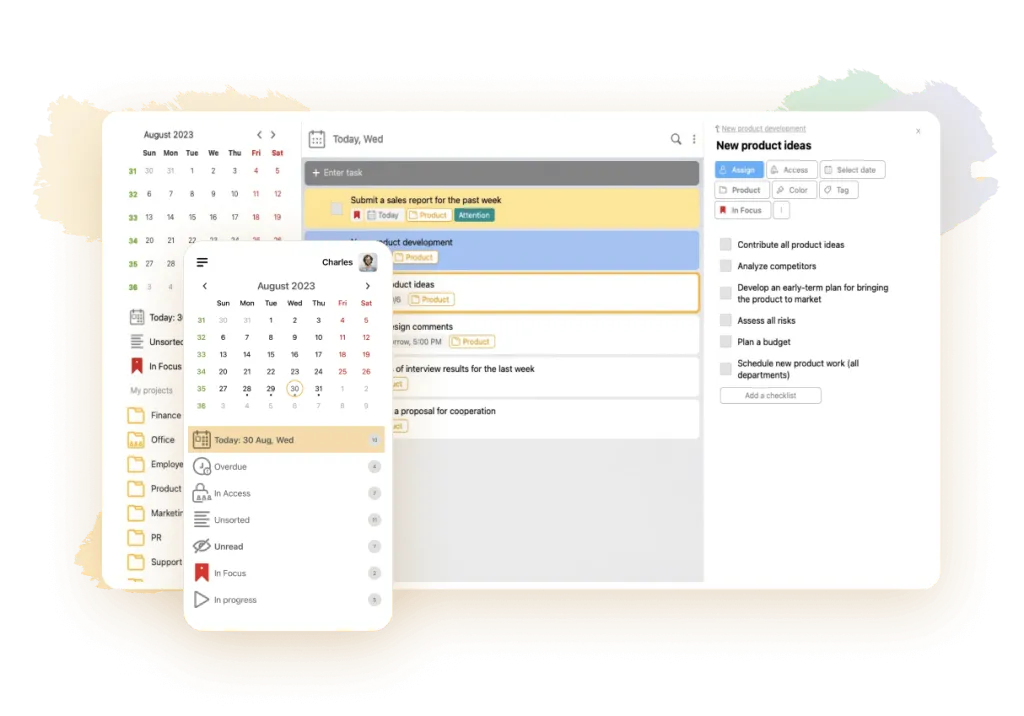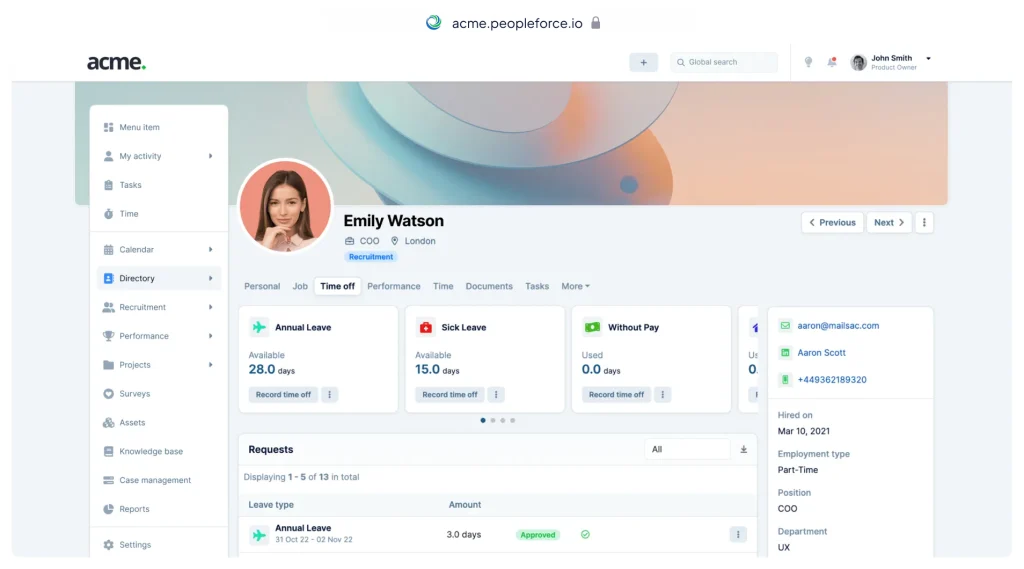
Max Miller
February 20, 2024
Personnel management is one of the most important tasks facing the head of any business. After all, the workforce of every organisation is an object that is inextricably linked to the production process, profit, success, and the company’s authority.
Employees make a purposeful contribution to the rise or fall of production based on their individual attitudes. Therefore, effective enterprise management should always aim at non-stop growth in the productivity of the firm’s workforce.
But how do you manage your company’s workforce as productively as possible? What exactly is labour team management? Does this area have peculiarities, goals and objectives, strategies and possible mistakes? What is included in them and is a priority? Is it possible to automate this process? We will answer these questions in the article.
Foundations of Organisational Personnel Management
People are the backbone of any socio-economic system, including small companies, large firms and huge corporations. Whatever the business, its employees are its main investment in training, hiring and then maintaining labour.
The head of the company should understand that personnel is the link on which the level of productivity of the entire organisation directly depends. The employees of the company are the main reason for the development and success of the business. Therefore, personnel management is considered to be an activity that is specifically aimed at the effective labour of the team in the company.
The human resource management process includes components such as:
-
Drawing up a plan for the company’s human resource needs.
-
Placement and selection of employees.
-
Organisation of work activities.
-
Indicators of motivation and stimulation of labour of employees of the enterprise.
To manage labour resources means to ensure productive use of employees, when the cost of the team is lower than its subsequent activity in the organisation. The level of employee utilisation directly depends on the amount of funds invested in creating the necessary conditions, including material and technical base, organisation of a comfortable workplace and recreation, reproduction of the labour resource.
Here also the pre-planning of the team is important. Before hiring employees, several factors are taken into account, such as the number of employees, their professional status, speciality, qualifications and assigned category.
Tracking the dynamics of the labour market environment significantly affects the application of organisational methods, technologies, functions and objectives of human resource management in a firm. For example, a negative demographic situation in the country can lead to a shortage of workers, which plays an important role in changing the motivation, incentives of work in all organisations.
Tasks of personnel management, what groups of tasks are included in this concept
The main objective of human resource management is considered to be the productive utilisation of human resources in the long term. This requires addressing a number of other equally important subtasks, which often include:
-
generating and shaping the overall strategy;
-
Determining the exact number of qualified employees, taking into account current enterprise team members;
-
drawing up work schedules, writing job descriptions for each of the company’s employees;
-
fast closing of vacancies, staffing of the labour collective;
-
Creating a talent pool from existing personnel for managerial positions;
-
Reducing the risk of losing valuable employees;
-
organisation of work taking into account the specifics of different workplaces;
-
management of material costs for the labour force;
-
analysing how well employees perform their duties;
-
implementation of professional retraining programmes for the company’s employees;
-
development of personnel evaluation standards for future performance appraisals, inspections;
-
Administering and enabling employees to move up the career ladder;
-
motivation to work effectively.
In large companies and huge corporations, it is physically impossible for one person to cope with all the main tasks. Therefore, the number of HR department specialists in financially stable firms should be at least 1-1.2% of the total number of the company’s personnel.

Principles of human resources management
The personnel administration mechanism is based on a number of critical principles that cannot be overlooked when planning the allocation of labour resources. For example, these include the following principles:
-
selection of employees based on personal and professional qualities, character traits, and individual characteristics;
-
the continuity of the working team, which consists in the organic combination of long-serving and newly arrived, inexperienced personnel;
-
career advancement of employees, regular career growth on condition of quality performance;
-
open competition, which consists of encouraging competition between employees applying for managerial seats and positions;
-
the totality of trust in personnel and systematic control over the execution of orders in accordance with instructions, orders, acts, etc;
-
matching the performer’s capabilities and skills to the profession, projects, assigned work;
-
auto-replacement of an employee who is sick or on leave;
-
skill development;
-
legal defence.
Thus, human resources must be managed through a coordinated approach across all areas. This includes timely recruitment, appointment of management positions, internships, etc.
Methods that help to manage staff
Administration of any team is based on a whole set of methods of influence on the employees of the organisation. It is necessary for the success of the business, its efficient functioning in the market. In total, three main groups of methods are distinguished in the personnel management system. They include economic, administrative and socio-psychological. Let us briefly analyse the structure of each group.
Economic
This group includes all methods of material stimulation of the labour collective. Among them, the most frequently used are such methods as personnel participation in the distribution of profits received by the company, wage increases, bonus payments for labour efficiency or quality, provision of social support (free meals, medical insurance, payment for transport, etc.), penalties and punishments in the form of deductions from wages.
Administrative
These methods are based on the use of coercive measures and regulations from the Labour Code of the Russian Federation by the company’s management team. Therefore, they include all orders, instructions and directives calling for compliance with labour discipline. They often imply certain responsibility of the employee for certain industrial offences.
The key feature is the immediate nature of the impact, immediate execution or putting into action the order, instruction of the management.
Socio-psychological
Impact methods based on the basic knowledge of principles in the field of sociology and psychology also play a significant role. They can minimise the number of debates, disputes and conflicts in the team, create a strong corporate culture, and manage career development, qualifications, skills and abilities of employees.
Moreover, these aspects help to identify informal leaders of the work team, determine the place of personnel in the team, and instantly resolve various clashes and quarrels between workers.
Human resources management strategies
Competitive, reliable and friendly staff of the organisation in theory and in practise achieves the goals set by the management if the team has a common concept of the organisation’s development, i.e. a certain strategy with a clear content.
All HR management strategies are characterised by two criteria: long-term and close connection with the general concept of the company’s development. Therefore, the five strategies currently used in the most developed modern corporations are considered to be the most effective: entrepreneurial, dynamic growth, profitability, liquidation and circulation. Let us consider each of them in more detail.
Entrepreneurial
Suitable for organisations that are engaged in a new type of activity. It is distinguished by the selection of personnel with risk-taking skills, initiative, contact and long-term co-operation orientation. Assumes competitive salaries and bonuses, evaluates on actual labour results. Trains the team in an informal, on-the-job setting and is often characterised by mentoring. Also promotes employees in their careers, taking into account their interests.
Dynamic growth
It has low risks, lays a strong foundation for further development of the firm, makes decisions based on a combination of goals and the means required to achieve them. It is characterised by the selection of the most loyal and flexible personnel who are able to take risks when necessary. Provides for fair bonus remuneration, evaluates labour according to predetermined criteria. It emphasises the development of each employee in the area of the core business. Plans reshuffle in the organisation taking into account corporate opportunities, and practices various forms of promotion.
Profitability
Suitable for enterprises that aim to maintain the existing level of profit. It is characterised by strict selection of personnel. Provides for monetary remuneration of employees based on professional merits, seniority and internal ideas of fairness. Stakes on concrete results and personal development. Plans personnel changes based on the company management’s perception of expediency.
Liquidations
It is used in corporations that sell assets to eliminate losses, plan to reduce staff due to falling profits. Characterised by unlikely recruitment of new employees. Provides for essentially merit-based pay with little or no increase and no incentives. Has a strict evaluation of employee performance according to managerial criteria. Develops and trains staff only when there is an acute business need. Promotes only those employees who have the skills and concepts required for the job.
Circles
It is used to save the company, which often entails drastic staff reductions. It is characterised by the selection of employees with versatile development and high qualifications. Pays according to a system of incentives and merit checks. Evaluates labour on the basis of performance. Trains employees only after careful selection. Promotes employees in various forms.
The main mistakes in personnel management
The fierce competition in the labour market does not allow modern companies to make mistakes in the process of personnel management, as it makes it very difficult to create a cohesive and friendly team of employees in the institution. Let’s look in more detail at some of the mistakes that make team building impossible.
Management’s indifference to the team
Indifference encourages experienced workers to quit and new workers not to stay with the company. High staff turnover leads to high training costs and reduced profitability due to a shortage of labour.
Unsuitable working conditions at the enterprise
Weak material and technical base, lack of Internet access, inadequate social guarantees (medical care, provision of sanatorium and spa treatment, small salaries, etc.) also force employees to quit in search of a better place of work.
Lack of career prospects and opportunities
This mistake is most often manifested in budgetary state organisations, where it is impossible to get a promotion without 5-10 years of service. Beginning specialists with ambitions are frightened by low salaries in the first years of work and prefer to leave for other companies where career is built on activity, initiative and quality performance of tasks.
Spontaneous recruitment
Lack of certain job requirements, unclear functionality and tasks also make staff agonise over a new job and then leave for more understandable competitors.
Lack of a selection strategy
Staff should be recruited on the spot in accordance with corporate ethics, goals and objectives, and the organisation’s strategy. If these are absent, the collective has no opportunity to become a cohesive team. In addition, when the system of requirements, standards and rules is constantly changing, the work also becomes unbearable.
Inadequate assessment of a candidate for a position
Requirements for candidates should be reasonable and clear. Discrimination should not be used on any grounds, such as appearance (girls under 25, model appearance, certain height, etc.).
Underestimated or overestimated requirements for a candidate for a position
Each specific position implies practical experience. You should not take a highly qualified specialist for a vacancy that is too easy, as he will waste skills and lose interest in the business and work. Nor should you take people without experience to a responsible position, as this threatens the firm with losses: profits, clients, orders, etc.
Misinforming the candidate
Deliberately withholding information about the full range of responsibilities, reward and punishment system, salary, etc. during the interview threatens the employee’s quick departure from the position, which again entails turnover and regular training costs for new employees.
There are other mistakes that a company may make in the process of personnel management. For example, incorrect setting of tasks, making unclear demands, loss of control over subordinates, violation of subordination, insufficient recognition of employees’ merits to the organisation, negative attitude towards the company’s employees. They severely undermine the authority of the organisation, push staff away from the management and the firm as a whole, and force them to look for a new place of work.

2 services that help in personnel management
A well-thought-out HR management system is a component of a company’s development strategy. After all, with its help, tasks, actions and necessary processes can be performed as clearly and promptly as possible. Therefore, automated HR operations systems implemented in the company’s labour practice simplify the life of both the company’s manager and HR services.
Large organisations with a large number of employees in geographically dispersed offices and divisions, practicing a complex salary system, as well as those engaged in production, trade, project and educational activities are in most need of special programmes for personnel management.
The programmes allow you to distribute assignments, exchange messages and job descriptions, calculate workloads, maintain document management, monitor task performance and much more. That’s why we’ve made a review of the best programmes that help your team work more efficiently.
1. LeaderTask

Unique electronic manager is suitable for teamwork, control of subordinates. Tools of the automated programme easily distribute and delegate tasks, create projects and set up work with them, provide shared experience for execution, process monitoring.
Tools:
-
the ability to create an endless list of tasks and subtasks, checklists, projects with coloured labels from the standard set or created according to individual settings;
-
automation, history, sorting, filtering of tasks;
-
individual access to tasks, “god mode” - view tasks of employees, team roles;
-
kanban-boards, visualising goals, creating plans and schedules;
-
client base, creation of forms for collecting applications in the constructor, processing of incoming applications;
-
ability to send orders and reassignments, control, make edits, send tasks for revision;
-
Employee productivity scale and task schedule;
-
the possibility of attaching any attachments;
-
inbuilt calendar, agenda, timetable, smart notifications, reminders;
-
Focus” function, which allows you to concentrate on the most important matters;
-
intelligent search, flexible settings;
-
widgets for browsers, creating tasks from emails;
-
offline mode and synchronisation;
Special conditions for scientific, educational institutions. There is a possibility of free test period - from 7 days, negotiated individually with the developer.
2. PeopleForce

A professional solution for automating HR management processes. Helps to create a culture of high performance in the organization, simplifies complex and time-consuming processes. It has a universal set of tools for HR management and candidate search.
Tools:
-
scheduling automation;
-
performance analysis;
-
database;
-
gamification;
-
adding employees, personnel records, job descriptions;
-
electronic document management;
-
mail integration.
Rates:
-
PeopleTime (for time and expense tracking for project teams) - from $20 per month for an annual subscription;
-
PeoplePulse (to create surveys and analyze employee feedback) - from $20 per month;
-
PeoplePerform (to set goals and track progress) - from $40;
-
PeopleHR (for daily tasks and routine automation) - from $60;
-
PeopleRecruit (to create job postings and manage the hiring of the best candidates) - from $119 per month.
Free test period - 14 days.
Conclusion
Choose from a variety of HR methods, strategies and applications that best suit you and your company. Build your dream team and don’t forget to meet the basic needs of your workforce. In this case, the increase in profits, success and development of the company will be guaranteed.








